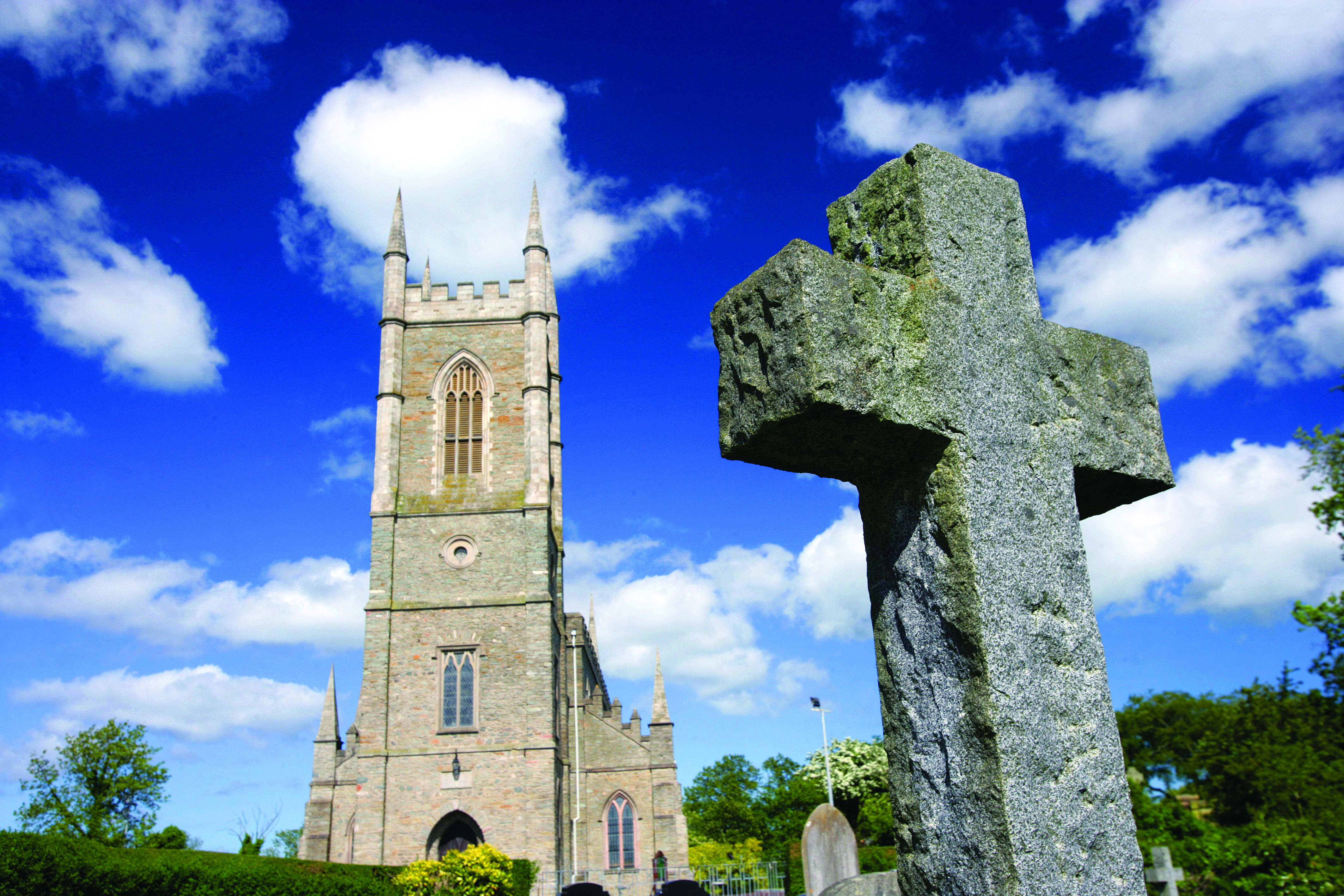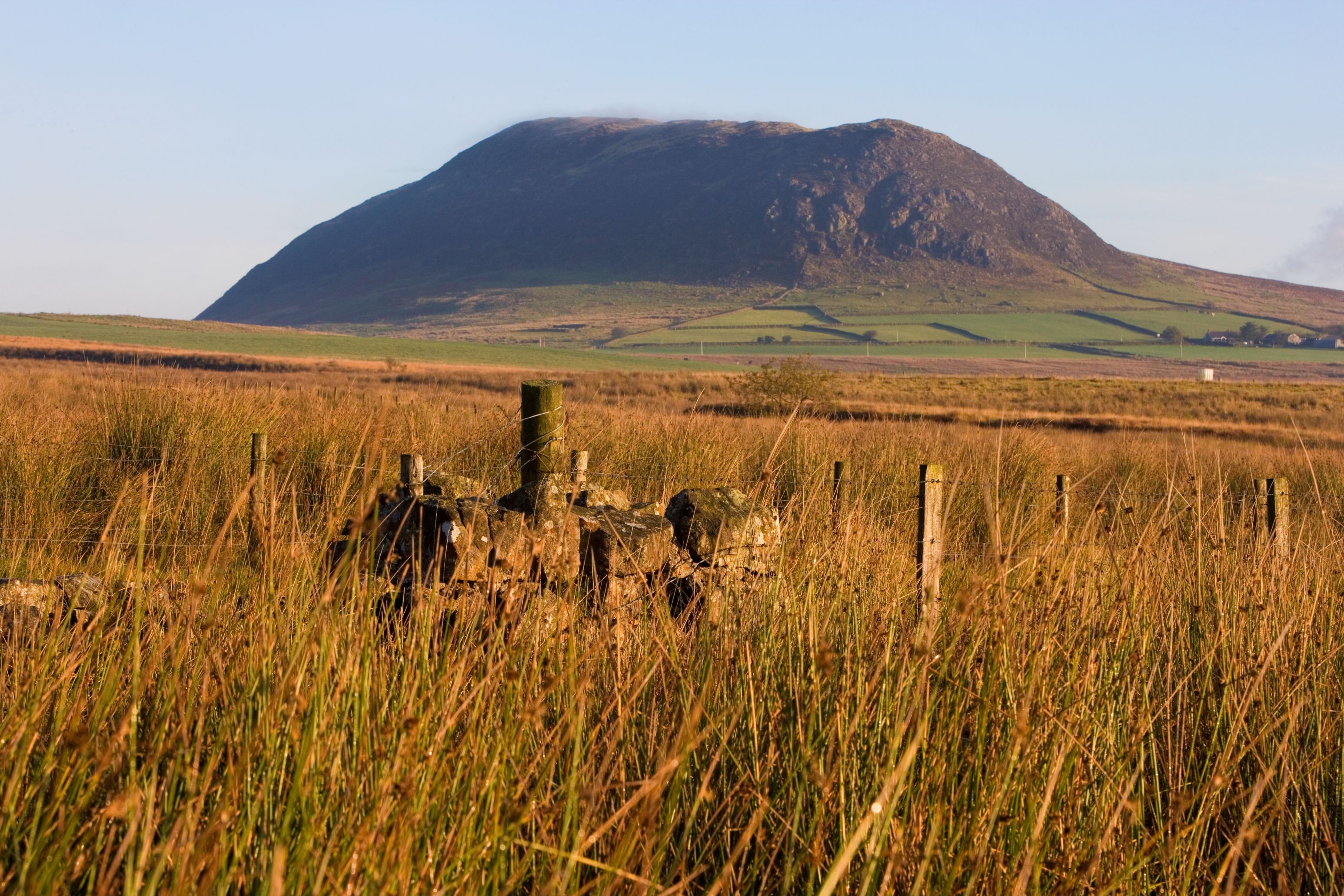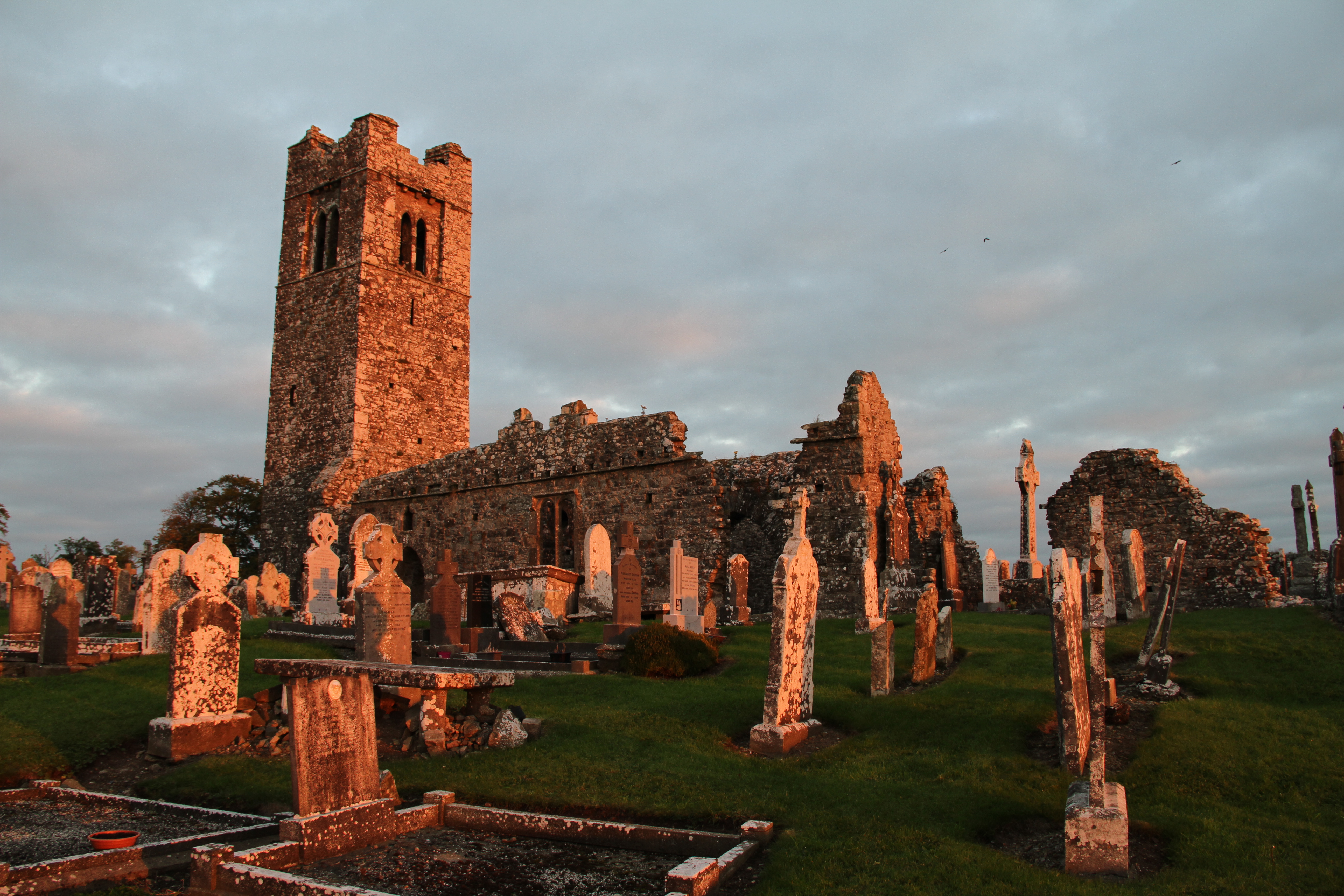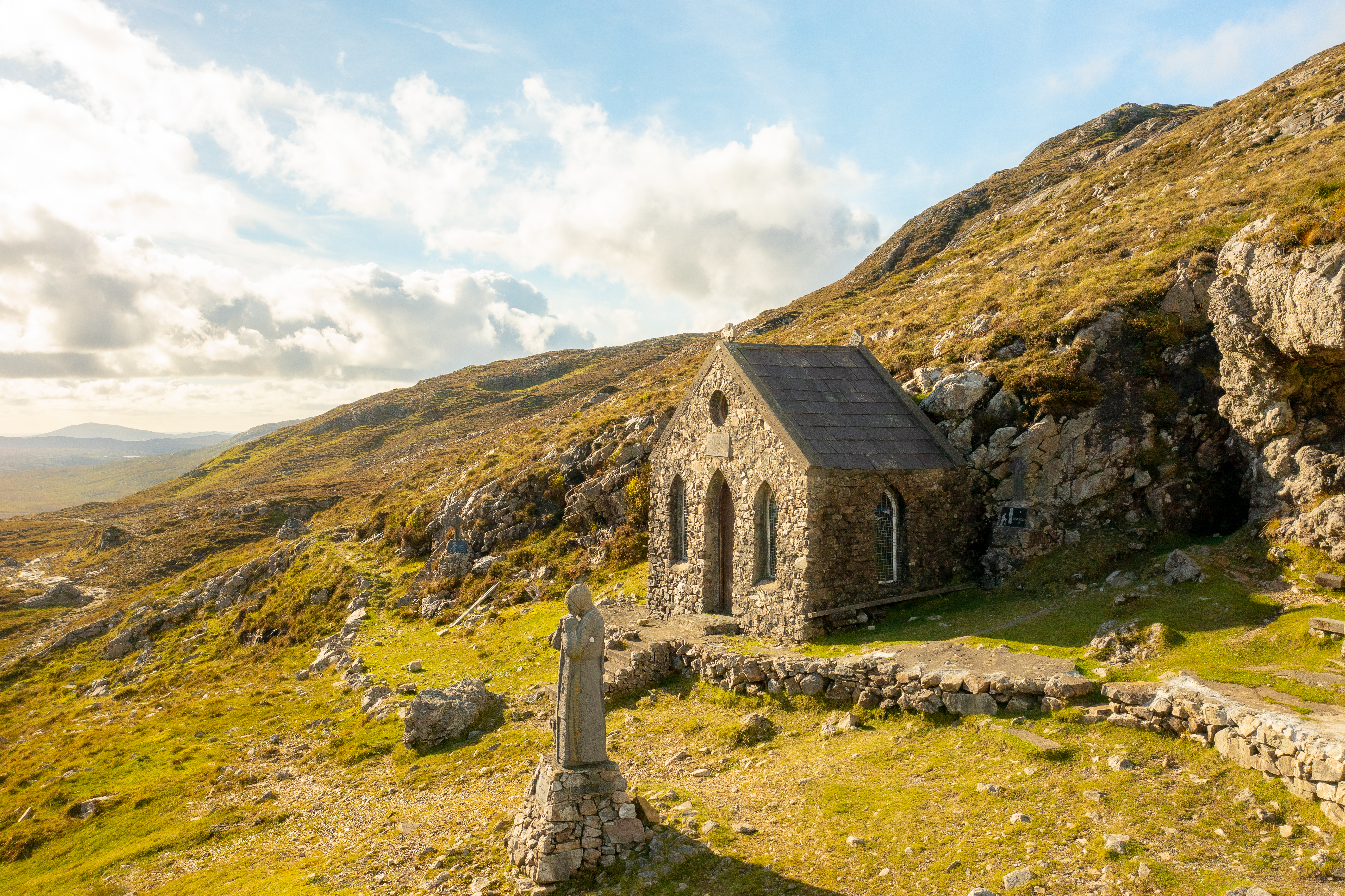Walk In St Patrick's Footsteps
St Patrick attracts people from all over the world to Ireland on March 17 for parades, parties and more. But how much do you really know about Ireland’s patron saint? We’ve got the lowdown on St Patrick’s life, as well as 10 great ways to connect with his legacy…

Down Cathedral with Stone Cross
Patrick, Ireland’s patron saint, left an indelible green mark on the world—a legacy that stretches from the Emerald Isle’s ancient ruins to almost every town and city around the globe. But who was the real St Patrick, the man whose name has become synonymous with shamrocks, parades, and global celebrations of all things Irish every March 17?
Born into a Romanized family in Britain in the 5th century, St Patrick was captured by Irish raiders at the age of 16 and spent several years in slavery. During this time, his faith became his anchor, providing him the strength to survive. After escaping, St Patrick was driven by a powerful vision that called him back to Ireland—not for revenge, but to bring Christianity to the very land that had once held him captive. This was to become the catalyst that ultimately shaped Ireland’s identity as the land of saints and scholars.
In addition to his missionary efforts, St Patrick’s exceptional ability to connect with the Irish people on a personal level was crucial to the spread of Christianity across the island. His genuine empathy and respect for local traditions helped break down barriers, enabling him to gain a following that transcended regional divides in ways never seen before. Patrick cleverly incorporated elements of native beliefs, such as the symbolism of the sun, making Christianity more relatable and eventually leading to the creation of the Celtic Cross.
His success in converting the Irish stemmed not only from his fervent faith but also from his understanding of the people he sought to lead, allowing him to bridge the gap between their pagan practices and the new faith. Through his leadership, Christian values became deeply embedded in Irish culture, setting the stage for Ireland to emerge as a centre of knowledge and spirituality in Europe during the Dark Ages.
St Patrick’s story blends history and legend, with the lines often blurred. One of the most enduring myths is that he drove all the snakes out of Ireland—a tale more symbolic than factual. Another well-known story is about the shamrock, which Patrick is said to have used to explain the Holy Trinity, forever linking the three-leafed plant to both Ireland and Christianity.
Every March 17, St Patrick is celebrated with shamrock-coloured beer, parades, jigs, reels, and the steady beat of drums and bodhrans in his homeland and abroad, while for that one day, the world dons a green filter. But if you truly want to walk in the footsteps of the man himself, we have 10 remarkable locations in which to explore his legacy.

Slemish Mountain, Co Antrim
Slemish, County Antrim
North of Belfast, Slemish Mountain offers a humbling glimpse into St Patrick’s early years when he was enslaved as a shepherd. Today, the mountain’s steep climb rewards hikers with panoramic views of the Antrim countryside. But what most visitors notice is the stillness – as if the mountain itself holds a memory of the hardships Patrick endured.
Downpatrick, County Down
As the place where St Patrick is said to have died on 17 March 461 AD, Downpatrick is one of Ireland’s most sacred sites. Here, visitors can pay their respects at the tomb of St Patrick at Down Cathedral. Nearby, the St Patrick’s Centre offers an immersive experience of the life of Ireland’s patron saint, bringing his legend to life through interactive exhibits.
Croagh Patrick, County Mayo
No St Patrick pilgrimage is complete without a trek up Croagh Patrick, the mountain that looms large in Irish legend. Known as the "Reek" to locals, it’s here where Patrick is said to have banished the snakes from Ireland. The hike up this sacred mountain is challenging, but the views of Clew Bay and the surrounding landscape make it more than worth the effort.

Hill of Slane, Meath
Slane, County Meath
On the Hill of Slane, history and mythology merge seamlessly. According to legend, this is where St Patrick lit a paschal fire to defy the pagan rituals of the Irish High King, Laoghaire. It was an act of defiance that marked the beginning of Ireland’s conversion to Christianity. Today, visitors can climb the hill to the monastic ruins and soak in the wide views of the Boyne Valley, a region rich in myth and Neolithic history.
Ardpatrick, County Limerick
In County Limerick, the hilltop village of Ardpatrick is a quiet destination where it’s believed that Patrick established one of his first monastic settlements. The views from the hilltop are stunning, offering a peaceful escape from the hustle and bustle of Ireland’s more famous landmarks.
Downpatrick Head, County Mayo
Rising dramatically from the ocean off County Mayo’s Downpatrick Head along Ireland’s Wild Atlantic Way, Dún Briste is a towering sea stack that seems almost otherworldly. While this site is more steeped in legend than fact, the story goes that St Patrick separated this rocky outcrop with a strike of his crozier from the mainland to banish the Druid chieftain Cromduff, who met his eternal fate in isolation on the island.

Mám Éan, Chapel, Pilgrimage Trail, Connemara, Co Galway
Mám Éan, County Galway
In the heart of Connemara, the Mám Éan Pass offers a glimpse into both Ireland’s ancient pagan roots and its Christian heritage. Once a sacred site for the festival of Lughnasa, marking the transition from summer to autumn, this breathtaking valley was later woven into the story of St Patrick, who is said to have passed through, blessing the land and its people. Today, pilgrims and visitors alike can follow in the saint’s footsteps along the Mám Éan Walk, a short but challenging hike that winds through the wild, unspoiled landscape.
Cashel, County Tipperary
Rising majestically above the surrounding plains, the Rock of Cashel is one of Ireland’s most magnificent sites, featuring a stunning cathedral, a round tower, and Cormac’s Chapel. Legend tells that Patrick baptised King Aengus here, though the story comes with a painful twist – Patrick accidentally pierced the king’s foot with his crozier. Despite the faux-pas, Aengus became the first Christian king of Munster.
Armagh City
Armagh holds a special place in St. Patrick’s legacy. It was here that he founded a church in 445 AD, establishing the city as Ireland’s ecclesiastical centre. Today, Armagh boasts two cathedrals – one Catholic and one Protestant. Visitors can explore these impressive buildings and delve into the area's rich ecclesiastical past while hiking along Saint Patrick’s Way, a pilgrim hike that stretches 132 km from Armagh city to Downpatrick.
Saul, County Down
Visiting Saul is a must-visit for anyone wishing to understand St Patrick’s missionary work in Ireland. It’s here that Patrick is said to have established the first Christian church in Ireland. The small Church of St Patrick marks this pivotal moment in Irish history. Take a hike up to Patrick’s Hill for a stunning view of Strangford Lough and the Mourne Mountains.
